List of World Heritage Sites in Laos
The United Nations Educational, Scientific and Cultural Organization (UNESCO) designates World Heritage Sites of outstanding universal value to cultural or natural heritage which have been nominated by countries which are signatories to the UNESCO World Heritage Convention, established in 1972.[1] Cultural heritage consists of monuments (such as architectural works, monumental sculptures, or inscriptions), groups of buildings, and sites (including archaeological sites). Natural features (consisting of physical and biological formations), geological and physiographical formations (including habitats of threatened species of animals and plants), and natural sites which are important from the point of view of science, conservation or natural beauty, are defined as natural heritage.[2] Laos, officially the Lao People's Democratic Republic, ratified the convention on 20 March 1987.[3]
As of 2022[update], Laos has three sites on the list. The town of Luang Prabang was listed in 1995, Vat Phou in 2001, and the Plain of Jars in 2019.[3] All three sites are cultural. In addition, Laos has two sites on its tentative list.[3]
World Heritage Sites[edit]
UNESCO lists sites under ten criteria; each entry must meet at least one of the criteria. Criteria i through vi are cultural, and vii through x are natural.[4]
| Site | Image | Location (province) | Year listed | UNESCO data | Description |
|---|---|---|---|---|---|
| Town of Luang Prabang |  | Luang Prabang | 1995 | 479bis; ii, iv, v (cultural) | Luang Prabang, the capital of the Lan Xang kingdom between the 14th and 16th centuries, was the royal and religious seat of the French protectorate of Laos between 1893 and 1946. The architecture of the city represents fusion of two styles: the traditional Lao and that of colonial Europe from the late 19th and early 20th century. Buildings include Buddhist temples, administrative and residential buildings. The town is well preserved. A minor boundary modification took place in 2013.[5] |
| Vat Phou and Associated Ancient Settlements within the Champasak Cultural Landscape |  | Champasak | 2001 | 481; iii, iv, vi (cultural) | Vat Phou (ruins pictured) is a Hindu temple constructed under the Khmer Empire which controlled the region from the 10th to 14th centuries. The cultural landscape also includes the remains of temples, towns, and water management structures, dating from the 5th to 15th centuries. The layout of the temple reflects the Hindu concept of an axis connecting mount Phou Khao with the Mekong river.[6] |
| Megalithic Jar Sites in Xiengkhuang – Plain of Jars |  | Xiangkhouang | 2019 | 1587; iii (cultural) | This site comprises 15 individual locations with remains of an Iron Age megalithic culture that existed roughly from 500 BCE to 500 CE. The "jars" refer to more than 2000 tubular stone jars that were used for funerary practices. There are also stone disks that were perhaps used as lids for the jars, other burial sites, and quarries, present at the locations.[7] |
Tentative list[edit]
In addition to sites inscribed on the World Heritage List, member states can maintain a list of tentative sites that they may consider for nomination. Nominations for the World Heritage List are only accepted if the site was previously listed on the tentative list.[8] As of 2022[update], Laos lists two properties on its tentative list.[3]
| Site | Image | Location (province) | Year listed | UNESCO criteria | Description |
|---|---|---|---|---|---|
| That Luang of Vientiane |  | Vientiane | 1992 | ii, iv (cultural) | Pha That Luang is a large gold-covered Buddhist stupa. It was constructed under king Setthathirath in 1566 after he moved the capital of the Lan Xang kingdom to Vientiane. The stupa is believed to house a relic of Buddha. The spire of the stupa reaches 45 m (148 ft) while the main structure is surrounded by reliquaries and sculptures.[9] |
| Hin Nam No National Protected Area |  | Khammouane | 2019 | viii, ix, x (natural) | The site covers a limestone plateau that exhibits a series of tropical karst features, such as cliffs, conical hills, and cave systems. The area is home to several endangered primate species, including the southern white-cheeked gibbon, red-shanked douc (a zoo specimen pictured), and Indochinese black langur. There are at least four species of hornbills, including the threatened wreathed hornbill.[10] |
References[edit]
- ^ "The World Heritage Convention". UNESCO World Heritage Centre. Archived from the original on 27 August 2016. Retrieved 21 September 2010.
- ^ "Convention Concerning the Protection of the World Cultural and Natural Heritage". UNESCO World Heritage Centre. Archived from the original on 1 February 2021. Retrieved 3 February 2021.
- ^ a b c d "Laos". UNESCO World Heritage Centre. Archived from the original on 22 March 2022. Retrieved 27 March 2022.
- ^ "UNESCO World Heritage Centre – The Criteria for Selection". UNESCO World Heritage Centre. Archived from the original on 12 June 2016. Retrieved 17 August 2018.
- ^ "Town of Luang Prabang". UNESCO World Heritage Centre. Archived from the original on 31 March 2022. Retrieved 3 April 2022.
- ^ "Vat Phou and Associated Ancient Settlements within the Champasak Cultural Landscape". UNESCO World Heritage Centre. Archived from the original on 22 March 2022. Retrieved 3 April 2022.
- ^ "Megalithic Jar Sites in Xiengkhuang – Plain of Jars". UNESCO World Heritage Centre. Archived from the original on 3 October 2020. Retrieved 3 April 2022.
- ^ "Tentative Lists". UNESCO World Heritage Centre. Archived from the original on 1 April 2016. Retrieved 7 October 2010.
- ^ "That Luang de Vientiane" (in French). UNESCO World Heritage Centre. Archived from the original on 21 October 2020. Retrieved 3 April 2022.
- ^ "Hin Nam No National Protected Area". UNESCO World Heritage Centre. Archived from the original on 21 October 2020. Retrieved 3 April 2022.


 French
French Deutsch
Deutsch

